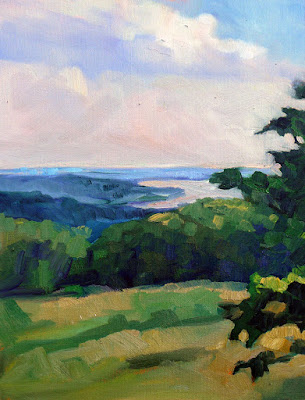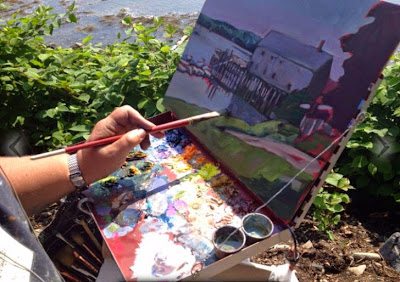 |
| Catskills over Athens, NY, 8X6, oil on canvasboard, Carol L. Douglas. The grass is courtesy of a park worker who was string-trimming nearby. Not to worry; it will pick off when the painting is dry. |
When Nancy Woogen and I were painting at North –South Lake on Thursday, a woman glided past us in her kayak. “Oh, you’re painters!” she exclaimed. “May I join you?”
Turns out she has been looking for her tribe. I introduced her to my pal Jamie Williams Grossman, chair of Lower Hudson Valley Plein Air Painters. We arranged to meet the following day at Site #9 on the Hudson River Art Trail, also known as Promenade Hill Park in Hudson, NY.
 |
| A tug approaching the Athens-Hudson Lighthouse in the Hudson River. |
Like many upstate New York towns, Hudson went into decline after its primary industry was closed down, but its industry wasn’t the usual paper or steel mill. For a century, Hudson was notoriousfor vice. Its red-light district included 50 bars, 15 whorehouses, two major illegal horse gambling rooms and a big-stakes floating crap game—all in a community of just a few thousand people. A series of high-profile raids in 1951 put an end to that. Hudson slumped into the familiar pattern of decay.
| Power lines crossing the Hudson, 8X6, oil on canvasboard, Carol L. Douglas. |
It’s been gentrified since my last visit, driven into the inexorable real-estate maw of New York City. This is great for the landowners of Columbia County, and not so good for those who need to buy or rent houses.
I talked to an artist who commutes to Manhattan and who is considering relocating to Troy, farther upriver. “Two hours on the train I can handle,” she said. “But two and a half is just too much.” Having done my time commuting from Rochester to Manhattan, I understand.
I painted a half-day at Promenade Hill, and decided to start the trek back to Rockport, ME, where my commute is, well, nothing at all.
Let me know if you’re interested in painting with me on the Schoodic Peninsula in beautiful Acadia National Park in August 2015. Click here for more information on my Maine workshops! Download a brochure here.






















